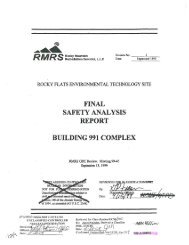silo 3 - U.S. Department of Energy
silo 3 - U.S. Department of Energy
silo 3 - U.S. Department of Energy
You also want an ePaper? Increase the reach of your titles
YUMPU automatically turns print PDFs into web optimized ePapers that Google loves.
L<br />
3<br />
4<br />
5<br />
6<br />
7<br />
8<br />
9<br />
10<br />
11<br />
12<br />
13<br />
14<br />
15<br />
16<br />
17<br />
18<br />
21<br />
22<br />
23<br />
24<br />
25<br />
26<br />
27<br />
28<br />
29<br />
30<br />
31<br />
32<br />
33<br />
34<br />
35<br />
36<br />
Silos Project Environmental Monitoring Plan<br />
40000-PL-0010<br />
. .? !\\ r-<br />
I’ I- .<br />
e- 5069<br />
c<br />
August 29, 2002<br />
. construction activities, it may be necessary to re-locate air monitors. Changes in monitoring<br />
locations will be documented and reviewed through the Design Change Notice (DCN) process.<br />
The sampling and analysis program will consist <strong>of</strong> bi-weekly isotopic thorium, radium-226, and<br />
total particulate analyses. Results from the isotopic thorium analysis (thorium-228, thorium-<br />
230, and thorium-232) will be used to specifically monitor thorium-230, the primary isotope<br />
<strong>of</strong> concern within the Silo 3 residues. The radium-226 analysis will be used to assess the<br />
effectiveness <strong>of</strong> prosess-control measures during the Silo 3 and AWR projects. Total<br />
particulate analysis will be used to determine if the results are indicative <strong>of</strong> project emissions<br />
or reflect the measurement <strong>of</strong> fugitive emissions from other sources (e.g. dust from<br />
construction vehicle traffic). The Project may evaluate the feasibility <strong>of</strong> changing the sample<br />
frequency (from biweekly to weekly or monthly) based upon factors such as historical results,<br />
the status <strong>of</strong> Silos Project activities, results from occupational particulate monitors, and the<br />
frequency <strong>of</strong> other IEMP boundary monitors. Any proposed change to the particulate sample<br />
analysis frequency will be documented and reviewed through the DCN process. .<br />
Samples will be analyzed according to the requirements for Analytical Support Level (ASL) B<br />
in the Sitewide CERCLA Quality (SCQ) assurance plan. The highest allowable minimal<br />
detectable concentrations (HAMDCs) for ASL B are 9.0 pCi/filter for isotopic thorium analyses<br />
and 4.0 pCi/filter for radium-226 analysis.<br />
3.2 Direct Radiation Monitoring<br />
In addition to airborne emissions, exposure to direct radiation is also a radiological hazard at<br />
the FEMP, particularly in the vicinity <strong>of</strong> Silo 1 and Silo 2. Direct, (penetrating) radiation is<br />
emitted from the radioactive materials stored onsite. The largest source <strong>of</strong> penetrating<br />
radiation at the FEMP results from the transformation <strong>of</strong> radium-bearing materials stored in<br />
Silos 1 and 2.<br />
The existing IEMP environmental monitoring network includes five locations that monitor direct<br />
radiation levels in the vicinity <strong>of</strong> Silos 1 and 2. The monitoring is conducted using<br />
thermoluminescent dosimeters (TLDs). The monitoring network has been established and the<br />
locations were strategically chosen to ensure a monitoring envelope for each radiation source.<br />
During the AWR Project, major sources <strong>of</strong> direct radiation at the FEMP will undergo change.<br />
For example, the operation <strong>of</strong> the Radon Control System (RCS) is expected to result in lower<br />
direct radiation levels on top <strong>of</strong> the <strong>silo</strong>s and elevated direct radiation levels adjacent to the<br />
carbon beds. The removal <strong>of</strong> the berm surrounding Silos 1 and 2 will result in changes to<br />
existing radiation shielding. These processes, together with the removal and relocation <strong>of</strong> the<br />
<strong>silo</strong> wastes to the Transfer Tank Area (TTA) may require modification <strong>of</strong> the IEMP TLD network<br />
to ensure adequate coverage <strong>of</strong> direct radiation sources.<br />
5 <strong>of</strong> 7<br />
000259
















